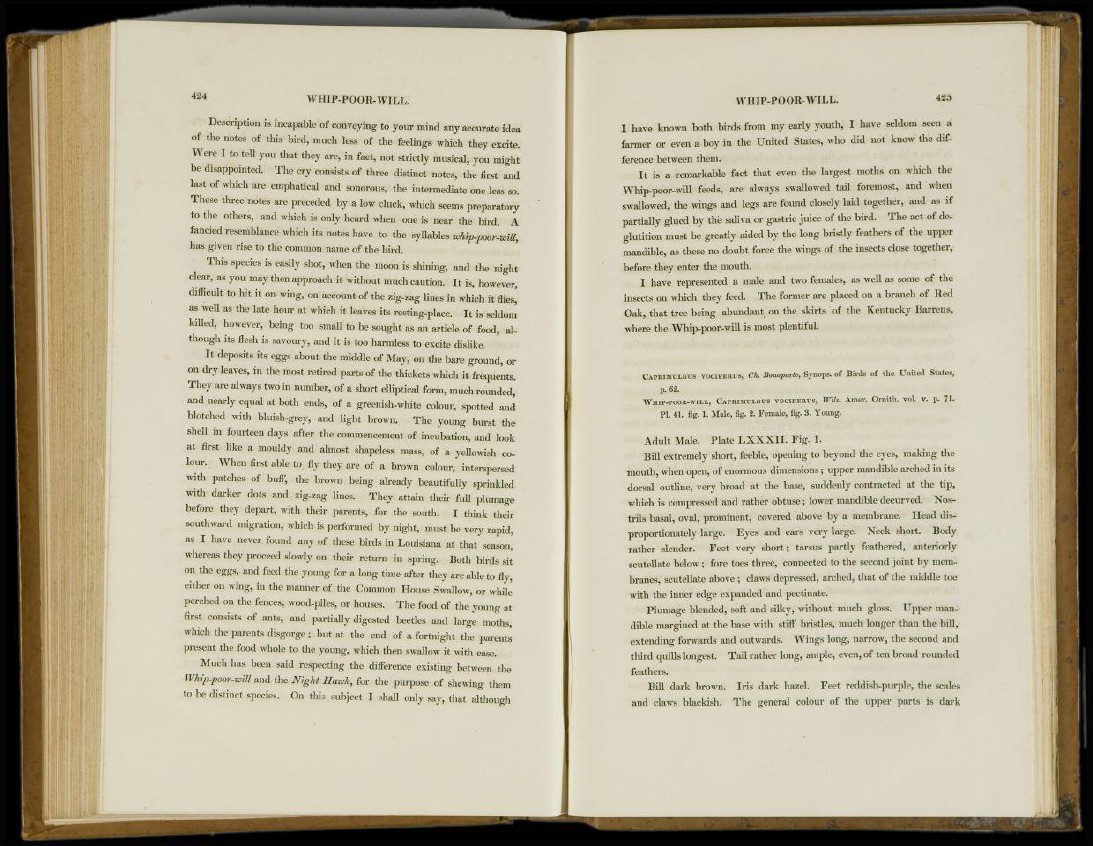
424 WHIP-POOR-WILL.
Description is incapable of conveying to your mind any accurate idea
of the notes of this bird, much less of the feelings which they excite.
Were I to tell you that they are, in fact, not strictly musical, you might
be disappointed. The cry consists of three distinct notes, the first and
last of which are emphatical and sonorous, the intermediate one less so.
These three notes are preceded by a low cluck, which seems preparatory
to the others, and which is only heard when one is near the bird. A
fancied resemblance which its notes have to the syllables whip-poor-will,
has given rise to the common name of the bird.
This species is easily shot, when the moon is shining, and the night
clear, as you may then approach it without much caution. It is, however,
difficult to hit it on wing, on account of the zig-zag lines in which it flies,
as well as the late hour at which it leaves its resting-place. It is seldom
killed, however, being too small to be sought as an article of food, although
its flesh is savoury, and it is too harmless to excite dislike.
It deposits its eggs about the middle of May, on the bare ground, or
on dry leaves, in the most retired parts of the thickets which it frequents.
They are always two in number, of a short elliptical form, much rounded,
and nearly equal at both ends, of a greenish-white colour, spotted and
blotched with bluish-grey, and light brown. The young burst the
shell in fourteen days after the commencement of incubation, and look
at first like a mouldy and almost shapeless mass, of a yellowish colour.
When first able to fly they are of a brown colour, interspersed
with patches of buff, the brown being already beautifully sprinkled
with darker dots and zig-zag lines. They attain their fidl plumage
before they depart, with their parents, for the south. I think their
southward migration, which is performed by night, must be very rapid,
as I have never found any of these birds in Louisiana at that season,
whereas they proceed slowly on their return in spring. Both birds sit
on the eggs, and feed the young for a long time after they are able to fly,
either on wing, in the manner of the Common House Swallow, or while
perched on the fences, wood-piles, or houses. The food of the young at
first consists of ants, and partially digested beetles and large moths,
which the parents disgorge ; but at the end of a fortnight the parents
present the food whole to the young, which then swallow it with ease.
Much has been said respecting the difference existing between the
Whip-poor-will and the Night Hard; for the purpose of shewing them
to be distinct species. On this subject I shall only say, that although
WHIP-POOR-WILL. 425
I have known both birds from my early youth, I have seldom seen a
farmer or even a boy in the United States, who did not know the difference
between them.
It is a remarkable fact that even the largest moths on which the
Whip-poor-will feeds, are always swallowed tail foremost, and when
swallowed, the wings and legs are found closely laid together, and as if
partially glued by the saliva or gastric juice of the bird. The act of deglutition
must be greatly aided by the long bristly feathers of the upper
mandible, as these no doubt force the wings of the insects close together,
before they enter the mouth.
I have represented a male and two females, as well as some of the
insects on which they feed. The former are placed on a branch of Red
Oak, that tree being abundant on the skirts of the Kentucky Barrens,
where the Whip-poor-will is most plentiful.
CAPHIMULGUS v o c i F E n u s , Ch. Bonaparte, Synops. of Birds of the United States,
p. 62.
WHIP-POOR-WILL, CAPUIMULGUS VOCIFEUUS, Wits. Amer. Ornith. vol. v. p. 71.
PI. 41. fig. 1. Male, fig. 2 . Female, fig. 3 . Young.
Adult Male. Plate LXXXII. Fig. 1.
Bill extremely short, feeble, opening to beyond the eyes, making the
mouth, when open, of enormous dimensions; upper mandible arched in its
dorsal outline, very broad at the base, suddenly contracted at the tip,
which is compressed and rather obtuse; lower mandible decurved. Nostrils
basal, oval, prominent, covered above by a membrane. Head disproportionately
large. Eyes and ears very large. Neck short. Body
rather slender. Feet very short; tarsus partly feathered, anteriorly
scutellate below; fore toes three, connected to the second joint by membranes,
scutellate above ; claws depressed, arched, that of the middle toe
with the inner edge expanded and pectinate.
Plumage blended, soft and silky, without much gloss. Upper mandible
margined at the base with stiff bristles, much longer than the bill,
extending forwards and outwards. Wings long, narrow, the second and
third quills longest. Tail rather long, ample, even, of ten broad rounded
feathers.
Bill dark brown. Iris dark hazel. Feet reddish-purple, the scales
and claws blackish. The general colour of the upper parts is dark